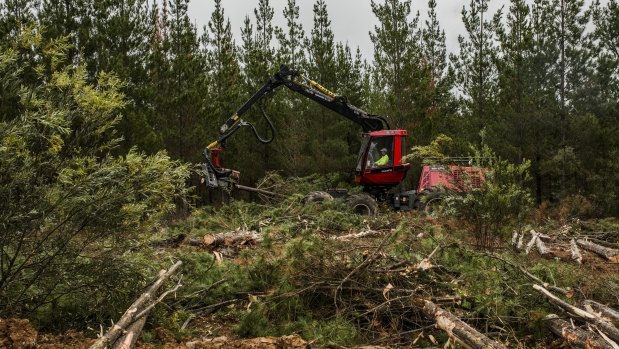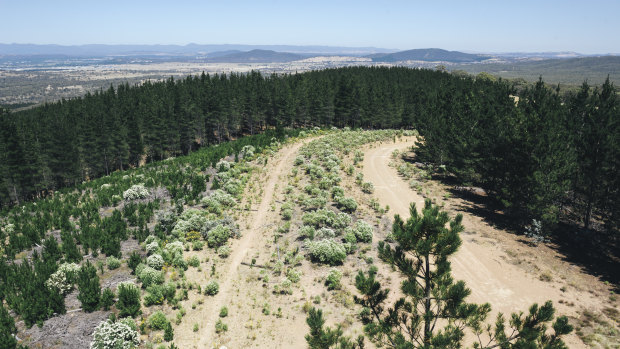This was published 6 years ago
Kowen could become Canberra suburbia, planning officials suggest
ACT planning officials have suggested that Kowen could eventually be developed despite chief minister Andrew Barr ruling out the possibility less than four months ago.
Speaking at a hearing for the inquiry into the ACT Planning Strategy 2018 on Friday, Environment, Planning and Sustainable Development Directorate executive director Kathy Cusack said the idea could be considered in a few years.

An excavator works to remove 3000 hectares of dead trees at Kowen Forest because of a freak combination of hail and fungal damage in 2016.Credit: Jamila Toderas
"While we're not proposing to progress with Kowen now because there are a number of different factors that mean it's simply not viable, it doesn't mean that in future reviews we wouldn't reconsider," Ms Cusack said.
"[We would] use those same tests looking at the location, physical attributes and infrastructure to guide us about whether it might be appropriate to have development there in the future."
The far north-eastern district, which is mainly covered by pine forests and farms, was looked at by the ACT government in 2004 but development was considered wildly too expensive, planning officials said.
Its main challenges had been water supply, sewage, stormwater management and access to Canberra's infrastructure, so the Molonglo Valley was seen as a better option.
Shortly before the planning strategy was released in December, chief minister Andrew Barr stressed the need to protect the territory's bushland and said the Kowen Forest would not be touched by development.
Future greenfield development would be in the Molonglo Valley and in areas between Weston Creek in the south and Belconnen in the north. "That's about it," he said.
"The ACT planning strategy is a long-term planning document and every five years, there's an opportunity for the government to review it," planning chief Ben Ponton said on Friday.
"In that time, we would have taken further work in investigating the west and that might help us reconsider Kowen.
"It's not saying that it's going to be looked at, it's just saying that in terms of the current constraints and the high-level work that's being done in terms of cost and servicing infrastructure, it's not for now."

Kowen had been looked at by planning officials as a potential place for development in 2016 but the exercise was deemed too costly.
The hearing for the planning strategy inquiry, hosted by the Standing Committee on Planning and Urban Renewal, also raised concerns about the future of the ACT's southern areas, particularly Tuggeranong.
Data in the planning strategy forecast a 29 per cent decrease in the district's population by 2041. About 20 per cent of Canberra's workforce lived in the valley but had to commute to the city for work, Liberal member for Brindabella Mark Parton said.
"I would have thought that ... creating employment in the valley would be required to underpin the urban renewal that must have a place in the area if we’re rolling at 70 per cent [of development being] urban infill," Mr Parton said.
"If it rolls out in the way that it's planned in the strategy, we would see some outcomes including mortgage stress, social issues, crime problems, rising youth unemployment, and migration away from the valley. That’s not a good picture.
ACT Planning Minister Mick Gentleman insisted that the data was misleading because it was based on historical figures. As older people in the suburb moved out of their homes and into aged care facilities, younger families would move in.
Recent data from the Australian Bureau of Statistics saw Tuggeranong emerge as a population-growth "hot-spot".
"What [the data] doesn't show is recent growth, particularly in Greenway, as new developments there have brought new populations into Tuggeranong, which is a good thing," he said.
"I think the opportunity for employment is there and one would imagine it will grow because there’s more people needed to develop and roll out federal government policy and actions at the same time.
"I think you'll see those figures fluctuate somewhat."
Mr Ponton said the statistic represented what would happen if the government didn't invest in the area's future.
A proposed review of the ACT Territory Plan would look to include district-level planning regulations, Mr Ponton said. The planning strategy inquiry continues.
With Katie Burgess